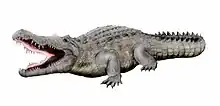| Ocepesuchus Temporal range: | |
|---|---|
| Scientific classification | |
| Domain: | Eukaryota |
| Kingdom: | Animalia |
| Phylum: | Chordata |
| Class: | Reptilia |
| Clade: | Archosauromorpha |
| Clade: | Archosauriformes |
| Order: | Crocodilia |
| Superfamily: | Gavialoidea |
| Genus: | †Ocepesuchus Jouve et al., 2008 |
| Type species | |
| †Ocepesuchus eoafricanus Jouve et al., 2008 | |
Ocepesuchus (meaning "Ocepe crocodile", in reference to the OCP, or Office Chérifien des Phosphates, a phosphate-mining company that participated in the excavation of the specimen) is an extinct genus of gavialoid crocodilian, related to modern gharials. Ocepesuchus is the oldest known crocodilian of Africa, and is known only from a single species, O. eoafricanus. It lived in Morocco during the late Maastrichtian age of the Late Cretaceous.[1]
Discovery and naming
Described by Jouve and colleagues in 2008, the type species is O. eoafricanus, with the specific name meaning "dawn African" in reference to its great age relative to other African crocodilians. Ocepesuchus had a long snout with a tubular shape, wider than high. It is the oldest known true crocodilian from Africa. The holotype of Ocepesuchus is OCP DEK-GE 45, a crushed but mostly complete skull, missing the end of the snout and part of its bottom surface, from late Maastrichtian (Late Cretaceous)-age rocks in the Oulad Abdoun Basin, in the vicinity of Khouribga, Morocco.[1]
Paleobiology
Ocepesuchus likely had a piscivorous diet based on its narrow snout, but it wasn't suited for eating large pycnodonts like Phacodus, with the preserved portion of its skull measuring only about 38 cm (15 in) long.[2] The type specimen is interpreted as either a small-sized adult or a subadult, and it may have spent its time in freshwater during its juvenile stages, similar to modern marine crocodiles; if this were indeed the case, some of the juveniles may have been protected to an extent from the Cretaceous–Paleogene extinction event.[1]
Classification
Jouve and colleagues performed a cladistic analysis incorporating their new taxon, and found Ocepesuchus to be a gavialoid.[1] A 2022 phylogenetic study by Iijima et al. recovered Ocepesuchus within Gavialinae, deeply nested within Gavialoidea, as shown in the cladogram below:[3]
| |||||||||||||||||||||||||||||||||||||||||||||||||||||||||||||||||||||||||||||||||||||||||||||||||||||||||||||||||||||||||||||||||||||||||||||||||||||||||||||||||||||||||||||||||||||||||||||||||||||||||||||||||||||||||||||||
References
- 1 2 3 4 Jouve, Stéphane; Bardet, Nathalie; Jalil, Nour-Eddine; Suberbiola, Xabier Pereda; Bouya; Baâda; Amaghzaz, Mbarek (2008). "The oldest African crocodylian: phylogeny, paleobiogeography, and differential survivorship of marine reptiles through the Cretaceous-Tertiary Boundary" (PDF). Journal of Vertebrate Paleontology. 28 (2): 409–421. doi:10.1671/0272-4634(2008)28[409:TOACPP]2.0.CO;2.
- ↑ Cooper, S.L.A.; Marson, K.J.; Smith, R.E.; Martill, D. (2022). "Contrasting preservation in pycnodont fishes reveals first record of regurgitalites from the Upper Cretaceous (Maastrichtian) Moroccan phosphate deposits". Cretaceous Research. 131 (4). 105111. doi:10.1016/j.cretres.2021.105111.
- ↑ Iijima M, Qiao Y, Lin W, Peng Y, Yoneda M, Liu J (2022). "An intermediate crocodylian linking two extant gharials from the Bronze Age of China and its human-induced extinction". Proceedings of the Royal Society B: Biological Sciences. 289 (1970): Article ID 20220085. doi:10.1098/rspb.2022.0085. PMC 8905159.


